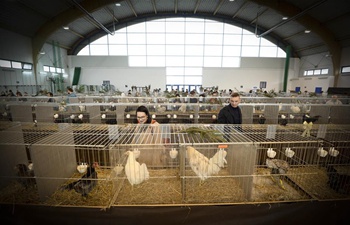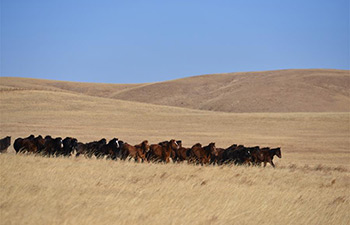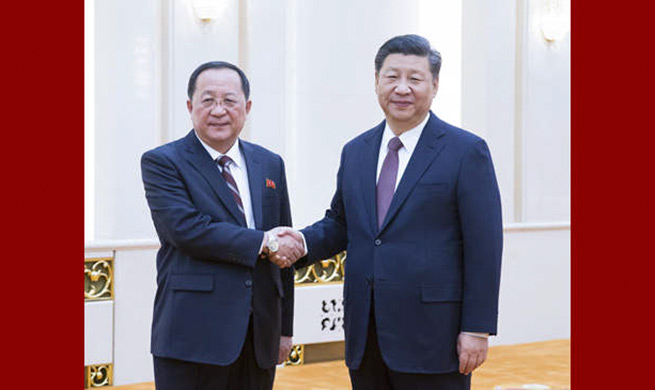by Xinhua writers Lan Gonglai, Zhang Zhilong
JINAN, Dec.9 (Xinhua) -- With digging machines roaring and walls being built brick by brick, a new generation greenhouse is under construction in Sanyuanzhu village, Shouguang, a major vegetable base in east China's Shandong Province.
The construction site is just a stone's throw from the office of Wang Leyi, the 78-year-old secretary of the village committee of the Communist Party of China. "Whenever I have time, I will come down and check out the progress," he said.
Wang has a lot of expectations for the new vegetable greenhouse. "Shouguang should be a leader in modern agriculture. The new greenhouse will use more machinery and less labor," said Wang.
The greenhouse will be equipped with automatic curtain rolling machines and automatic sprayers, which farmers can control them remotely on their phones, according to a contractor.
AN INDUSTRY PIONEER
Wang was elected the village Party chief in 1978, just as China began its reform and opening-up drive.
With the household contract responsibility system introduced in late 1970s, which allowed farmers to own farmland through a collective, often a village committee, farmers of Sanyuanzhu village started growing fruits on barren slopes in hopes of raising income to buy food and clothes.
But they were far from being rich. Wang began to think about making fresh vegetables available all year round, even in winter.
In north China, it is cold in winter. Fresh vegetables back then were in short supply except cabbages and radishes. Wang thus saw an opportunity.
"Developing large-scale greenhouse farming could bring customers in northern China a variety of fresh vegetables in winter, though at higher prices, and this could help us get rich quick," recalled Wang.
Growing vegetables in freezing cold in north China winter had been a headache for locals, as they had to burn coal to raise temperatures inside a kind of makeshift greenhouse, and the demand for coal was around five tonnes each winter.
Wang went to six provinces and cities in 1988 and early 1989 to seek better vegetable growing techniques. Based on what he learnt from those visits, Wang built a new greenhouse which did not require coal but relied solely on sunlight for warmth in winter.
At first, most fellow villagers did not believe such greenhouses could work because they were costly.
Wang later managed to persuade 16 fellow villagers to join him in building similar greenhouses using sunlight for warmth in mid-1989, starting with growing cucumbers. In the winter that year, the 17 early birds had the first taste of success and earned much more from cucumber sales compared to those who didn't. The whole village later followed suit.
A GROWING MARKET
Shouguang, now a county-level city, has become a major vegetable growing base and well-known in China since more farmers joined greenhouse vegetable growing business in the 1990s.
With the greenhouses built with the technique shared by Wang, local farmers can grow more varieties of fresh vegetable to provide the market in winter and find a way to make more money and become prosperous.
Wang Leyi has also taken the lead in expanding the market. He even brought fresh vegetables and went to Hong Kong, Russia in search of potential buyers, but was met with setbacks.
"Customers in Hong Kong did not like cucumbers with thorns, and those in Russia thought our tomatoes were too juicy," he said, adding he then realized that people from different places had different eating habits for vegetables, so their demands varied.
Wang Leyi invited top companies in the seed industry to his village, helping farmers grow new varieties of vegetables to meet the demands of global markets.
Shouguang has more than 40,000 hectares of greenhouses and trades around 8 million tonnes of vegetables a year. It provides Beijing with one-third of the vegetables on the market.
Shouguang has been cited as a modern agricultural demonstration zone and has provided integrated vegetable growing solutions to more than 20 provincial-level regions, said Vice Mayor Wang Lijun of Shouguang.
AIMING HIGH
Over the past three decades, Wang and other locals have developed several generations of greenhouses to make a good use of new and smart technology and large machinery, meeting the country's growing demand for high-quality vegetables and making good money.
There has been a growing consumer demand for green and organic vegetables in China, and more producers have turned their focus to quality over quantity.
"We are exploring more cutting-edge greenhouse technologies and setting up quality tracing systems and market channels," said Xu Meirong, a researcher with the agricultural bureau of Shouguang City.
Wang Leyi is now busy working on a museum on farming.
"Shouguang is a major vegetable base in the country and our village is cradle where greenhouse vegetables are grown in winter, we should have the responsibility to find a new approach in executing the rural vitalization strategy while enshrining our wonderful farming in a museum."

















